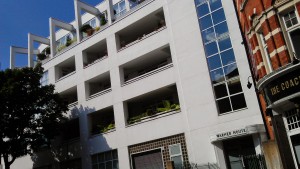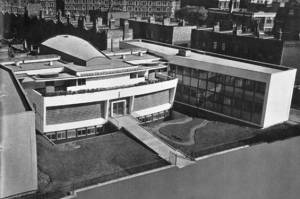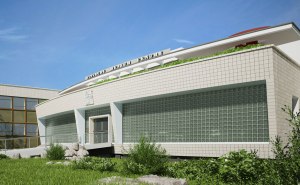There is something quite intriguing about the way modernism seems to fit perfectly with certain building types. Indeed, some architecture movements do tend to find a niche and that’s mostly to do with governments contracting certain practices to do public buildings and then a trend emerges. A good case study would be the USSR where brutalism seemed to be the de-facto go to style for everything governmental. Whether it was city halls or plain old gargantuan mammoth structures to reflect the might of the empire during the cold war, the Russians loved themselves some concrete (much to my amusement and delight). That’s another topic that we’ll go into some other time hopefully.
Yesterday I was wandering the beautiful streets of Clerkenwell and Finsbury, an area that has been a playground for modernist architects (alongside all of North London) since the movement emerged. And while the British government of today is very reserved and lacks any sort of ambition (and frankly has no cash), the days of post WWI and WWII Britain were all about grand statements. Governments built entire new cities from scratch in attempt to tackle London’s massive population bubble (Milton Keynes, WGC, High Wycombe etc) – I’ve written extensively about this here. And modernism was the weapon of choice at the time, hence we are now blessed with an abundance (though not merely as enough as I’d like) of mid-century delights dotted throughout London. So as I was walking in search of the recently renovated Warner House (which I eventually found and admired for about 15 minutes as passers by wondered what the hell I was so interested in), I stumbled across one of the most amazing buildings I’ve yet to come cross in this fair city.
Tucked in a small corner between Pine Street and Vineyard Walk, just as you exit the amazing and as I was about to later find out same architect designed ‘Spa Fields’, you get a peak of the elegant ‘Finsbury Health Centre’. At first I was immediately taken a back by the symmetry of that marble tiled facade with the beautiful grid patterned glass block windows. I’ve never seen this type of front before, not in London, it was quite inspired by the work of Le Corbusier, but not fully. Really, it was it’s own thing. Then I took a step back, and suddenly a new angle emerges, now you can see the beautiful interplay between a central structure and the extension wings on each side, they’re like a hand holding a pearl gently afraid to let go. As the sun shines, the marble and glass tiles reflecting positive energy, I start to contemplate the building’s almost sultry curves. They gently twist and turn as the details of the balcony and the first floor start to emerge. Now you know it’s not quite Le Corbusier! You can just imagine how unbelievably cutting edge this was at the time. I would say it still is as sadly today’s architecture lack any sort of ambition or vision (again, another topic for another day).
I’m so intrigued, I need to find out more. So I start doing some research, and my suspicions are immediately ratified. This was indeed part of a governmental project for the area between WWI and WWII, it was a bid by the socialist Labour run local council of the time to regenerate the entire area through its socialist vision (Finsbury was a slum those days – imagine). Those of you who don’t quite know, this part of London has always been staunchly leftist. Every anti-cuts pro-unionist movement that ever materialized in the city had its roots from the area stretching from the aptly named Red Lion square to Clerkenwell, and from Upper Street down to Bloomsbury. These are the red and proud areas of London (at least they were before the super gentrification of the 90s and 2000s). And through modernism, the vehicle for social change was set.
The architect chosen to take on this massive project was none other than Berthold Lubetkin, the man widely accredited with making modernism mainstream in the United Kingdom. His practice Tecton was a government favorite, designing everything from the now legendary Penguin Pool at the London Zoo, to the amazing Highpoint I tower in Highgate. And through the FHC, Lubetkin was able to mobilize modernism’s social function by providing free health care to all. Furthermore, he achieved another of modernism’s goals, providing upscale dreams (through concrete) to the underprivileged. And this was no charity, thus a political goal was also struck, a government owned and operated universal health care centre. What more can an aspiring modernist architect ask for?
It was therefore such a devastating loss to this part of London when WWII started and all of Tecton’s plans for the area were thrown in the bin. Luckily Finsbury Health Centre was well and kicking by that time, and so was the amazing ‘Spa Fields’ next door.
A part of me can’t help but wonder what if WWII didn’t ravage London, would we now have an area that is completely modernist?! Dreams indeed, but one thing is for certain, no architecture movement has quite managed to fulfill its social and political goals like modernism has. Call it elitist and you fail, because although 50s and 60s villas and mansions through America’s west coast are staunchly modernist, European social housing, just as modernist, refutes this. Call it oppressive and fascist and you fail, because just as governmental as it was (a certain Oscar Niemeyer pops to mind), it was also the vehicle for rebellion against governments, just look at Bauhaus. The real question is, how calm the quality of architecture and design has deteriorated so rapidly in the past 4 or 5 decades?
Though the building is indeed Grade I listed, the highest possible protection in the UK, it is suffering on the outside and can indeed use an uplift. In 1995 Avanti finished a partial rework of the interior, but as a recent case study by c20 reveals, in order to preserve the future of this building some pertinent work is needed. Let’s hope that the government or local council manages to set aside some cash for this so that it can continue to serve all its intended functions, socially and aesthetically. One thing lives on though, and that is Lubetkin’s ideal: “nothing is too good for ordinary people”.










